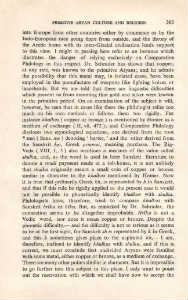Page 582 - Lokmanya Tilak Samagra (khand 2)
P. 582
PRIMITIVE ARYAN CULTURE AND RELIGION 363
into Europe from other countries either by commerce or by the
Indo-European race going there from outside, and the theory of
the Arctic home with its inter-Glacial civilisation lends support
to this view. I might in passing here refer to an instance which
illustrates the danger of relying exclusively on Comparative
Philology in this respect. Dr. Schnider has shown that copper,
at any rate, was known to the primitive Aryans; and he admits
the possibility that this metal may, in isolated cases, have been
employed in the t;nanufacture of weapons like fighting knives or
lanceheads. But we are told that there are linguistic difficulties
which prevent us from assuming that gold and silver were known
in the primitive period. On an examination of the subject it will,
however, be seen that in cases like these the philologist relies too
much on his own methods or follows them too rigidly. For
instance khalkos ( copper or bronze ) is mentioned by Homer as a
medium of exchange ( II, vii, 472 ) ; and Comparative Philology
discloses two etymological equations, one derived from the root
* mei ( Sans. me) denoting ' barter, ' and the other derived from
the Sanskrit kri, Greek priamai, meaning purchase. The ~ig
Veda ( VIII, I, 5 ) also mentions a measure of the value called
shulka, and, as the word is used in later Sanskrit literature to
denote a small payment made at a toll-house, it is not unlikely
that shulka originally meant a small coin of copper or bronze
similar in character to the khalkos mentioned by Homer. Now
it is true that ordinarily Greek kh, is represented by h in Sanskrit,
and that if thi; rule be rigidly applied to the present case it would
not be possible to phonetically identify khalkos with shulka.
Philologists have, therefore, tried to compare khalkos with
Sanskrit hr£ku or hfku. But, as remarked by Dr. Schrader, the
connection seems to be altogether improbable. Hr£ku is not a
Vedic word, nor does it mean copper or bronze. Despite the
phonetic difficulty,- and the difficulty is not so serious as it seems
to be at the first sight, for Sanskrit sh is represented by k in Greek,
and this k sometimes gives place to the aspirated kh,- I am,
therefore, inclined to identify khalkos with shulka, and if this is
correct, we must conclude that undivided Aryans were familiar
with some metal, either copper or bronze, as a medium of exchange.
There are many other points similar in character. But it is impossible
to go further into this subject in this place. I only want to point
out the reservation with which we shall have now to accept the

